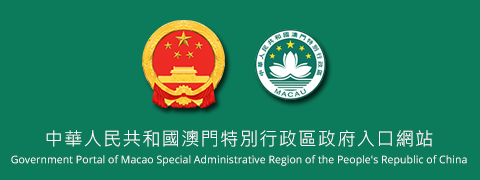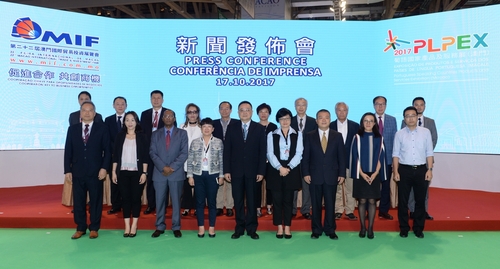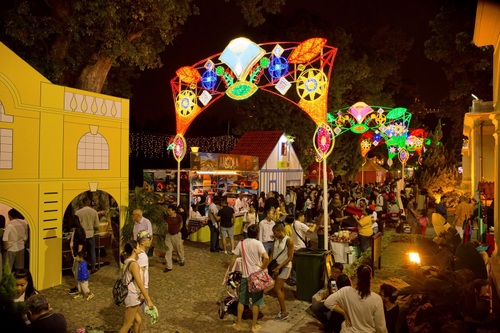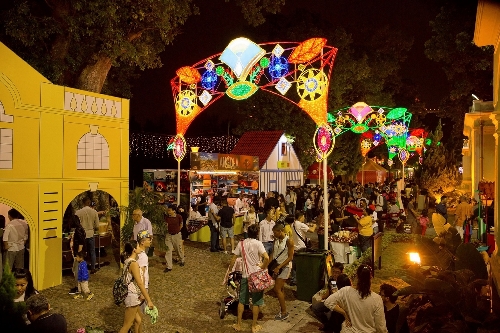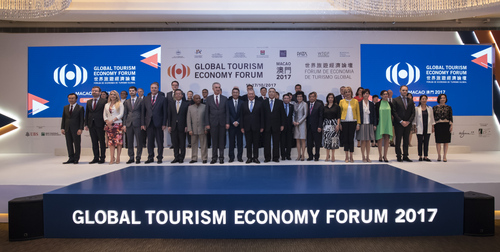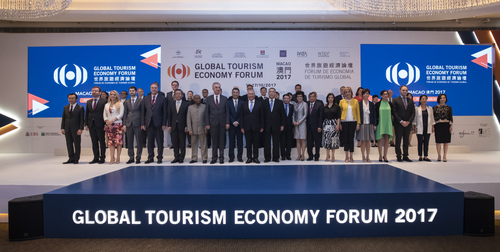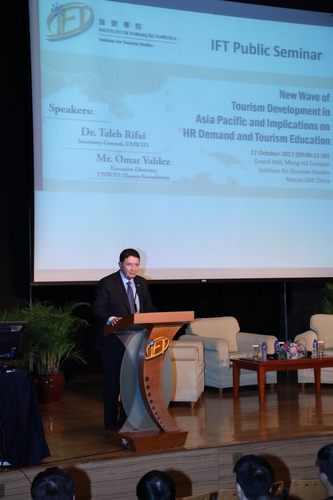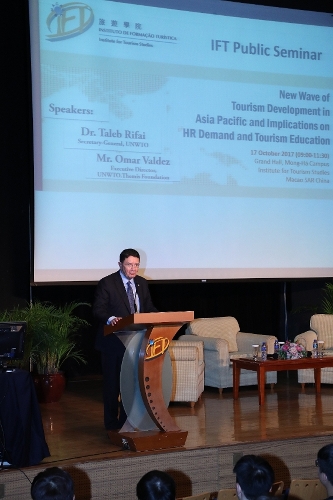Macao SAR Government Portal
News
Reaching out Advantages of Sino-Portuguese Platform Stay Abreast of New Moves in Domestic and Overseas Economic and Trade Developments Two Concurrent Events Held in October
The “22nd Macao International Trade and Investment Fair” (22nd MIF) and “2017 Portuguese-Speaking-Countries Products and Services Exhibition (Macao)” (2017 PLPEX) will be held concurrently from 19th to 21st October 2017 at The Venetian Macao. MIF and PLPEX will join hands with enterprises from Mainland China, overseas and Macao to advance in the “Belt and Road”, “Guangdong-Hong Kong-Macao Greater Bay Area construction” as well as to promote the development of “One Centre, One Platform”, namely “World Centre of Tourism and Leisure” and “Business and Trade Co-operation Service Platform between China and Portuguese-Speaking-Countries”, and also promote the moderate diversification of Macao’s economy. The press conference is scheduled to take place today (17th) to provide the up-to-date information of the two events.
…
20th Lusofonia Festival opens on Thursday Varied programme offers experiences of lusophone cultures
Organized by the Cultural Affairs Bureau (IC, from the Portuguese acronym) and the Permanent Secretariat of Forum for Economic and Trade Co-operation between China and the Portuguese-speaking Countries (Macao), and co-organized by the Macao Government Tourism Office and the Civic and Municipal Affairs Bureau, the 20th Lusofonia Festival kicks off on Thursday, 19 October, and will run from 19 to 22 October, at the Taipa Houses for four consecutive days, introducing Macao’s unique lusophone culture. Residents and tourists are welcome to participate and experience the warm lusophone atmosphere.
…
20th Lusofonia Festival opens on Thursday Varied programme offers experiences of lusophone cultures
Organized by the Cultural Affairs Bureau (IC, from the Portuguese acronym) and the Permanent Secretariat of Forum for Economic and Trade Co-operation between China and the Portuguese-speaking Countries (Macao), and co-organized by the Macao Government Tourism Office and the Civic and Municipal Affairs Bureau, the 20th Lusofonia Festival kicks off on Thursday, 19 October, and will run from 19 to 22 October, at the Taipa Houses for four consecutive days, introducing Macao’s unique lusophone culture. Residents and tourists are welcome to participate and experience the warm lusophone atmosphere.
…
Chief Executive attends closing ceremony of Global Tourism Economy Forum • Macao 2017 GTEF 2018 will invite European Union as Partner Region
The Chief Executive of the Macao Special Administrative Region, Chui Sai On, was present in the closing ceremony of Global Tourism Economy Forum • Macao 2017 (“GTEF” or “the Forum”) today (17 October). Hosted by the Secretariat for Social Affairs and Culture of the Macao SAR Government, the Forum supports China’s Belt and Road Initiative and embraces the “16+1” economic framework between China and the 16 Central and Eastern European Countries (“CEEC”) in this edition. Through a range of themed panel sessions and business networking functions, the Forum fostered an in-depth exchange of perspectives among industry stakeholders from near and afar across the world. While radiating Macao’s unique strengths and role as a platform, GTEF 2017 culminated in a fruitful harvest.
…
Consumer Council released latest ‘Supermarket price survey’ Surveyed spots included supermarkets in N. Sra. de Fátima Parish
Consumer Council conducted its second ‘Supermarket price survey’ in September on 17 October for the implementation of Section 2b), Article 10, Law 4/95/M of 12 June. Surveyed locations included 14 supermarkets in Toi San, Ilha Verde and Fai Chi Kei areas in N. Sra. de Fátima Parish.
…
Chief Executive attends closing ceremony of Global Tourism Economy Forum • Macao 2017 GTEF 2018 will invite European Union as Partner Region
The Chief Executive of the Macao Special Administrative Region, Chui Sai On, was present in the closing ceremony of Global Tourism Economy Forum • Macao 2017 (“GTEF” or “the Forum”) today (17 October). Hosted by the Secretariat for Social Affairs and Culture of the Macao SAR Government, the Forum supports China’s Belt and Road Initiative and embraces the “16+1” economic framework between China and the 16 Central and Eastern European Countries (“CEEC”) in this edition. Through a range of themed panel sessions and business networking functions, the Forum fostered an in-depth exchange of perspectives among industry stakeholders from near and afar across the world. While radiating Macao’s unique strengths and role as a platform, GTEF 2017 culminated in a fruitful harvest.
…
Consumer Council conducts price survey on selling prices of fresh pork and vegetables from Zhuhai, HK, and Macao
For the implementation of Section 2b), Article 10, Law 4/95/M of 12 June, Consumer Council collects prices of fresh pork from wet markets and supermarkets for consumers’ reference on 17 October. The mentioned data collected during 11 October to 17 October are used for comparing the average selling price of the same products from Zhuhai and Hong Kong. The relevant data has been uploaded to the Council’s website for consumers’ reference.
…
Consumer Council conducts price survey on selling prices of fresh pork and vegetables from Zhuhai, HK, and Macao
For the implementation of Section 2b), Article 10, Law 4/95/M of 12 June, Consumer Council collects prices of fresh pork from wet markets and supermarkets for consumers’ reference on 17 October. The mentioned data collected during 11 October to 17 October are used for comparing the average selling price of the same products from Zhuhai and Hong Kong. The relevant data has been uploaded to the Council’s website for consumers’ reference.
…
UNWTO Secretary-General shares insights on tourism development in Asia Pacific and implications on HR demand and tourism education at IFT
On 17 October, the Institute for Tourism Studies(IFT) held a public seminar with the World Tourism Organisation (UNWTO) on tourism development in Asia Pacific, human resources demand and tourism education. Secretary-General of World Tourism Organisation(UNWTO), Dr. Taleb Rifai, and Executive Director of UNWTO. Themis Foundation, Mr. Omar Valdez were the keynote speakers.
…
UNWTO Secretary-General shares insights on tourism development in Asia Pacific and implications on HR demand and tourism education at IFT
On 17 October, the Institute for Tourism Studies(IFT) held a public seminar with the World Tourism Organisation (UNWTO) on tourism development in Asia Pacific, human resources demand and tourism education. Secretary-General of World Tourism Organisation(UNWTO), Dr. Taleb Rifai, and Executive Director of UNWTO. Themis Foundation, Mr. Omar Valdez were the keynote speakers.
…
